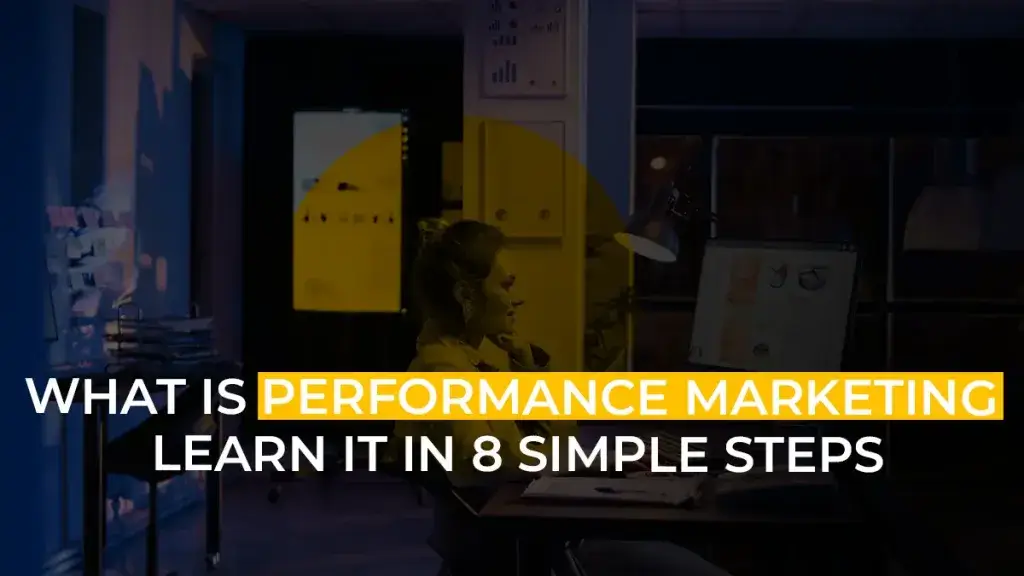What Is Performance Marketing & How to Learn It?

Here's What We've Covered!
One of the things that puts digital marketing above traditional media is its ability to offer real-time insights into the success or failure of an ad campaign. Thus, performance marketing as a sub-field of digital marketing is gaining a lot of traction.
If you’re looking for an easy guide to walk you through the A to Z of performance marketing, you’re in the right spot. Towards the end, a bonus point is awaiting you! Read on to know more.
What Is Performance Marketing?
Let’s paint a picture for you to understand this:
Usually, businesses burn a hole in their pocket by investing in an ad campaign and it takes a lot of time for the results to be visible. At the same time, there’s no guarantee of the success of ads as ultimately any ad campaign is simply a gamble with the future. However, in this gamble, they are at a loss since they have to bear the costs even if the ad campaign fails.
In such a scenario, performance marketing offers a better alternative by making them pay every time their target audience takes a predetermined action. For instance, you put a Google ad for the keyword “bakeries in Andheri”. Every time a user searches for this keyword or some variation of this, your ad is likely to be displayed. You won’t pay every time the ad is displayed on your target audience’s screen (impression) rather you will pay every time they click it.
Thus, performance marketing can be understood as any marketing activity where the businesses pay their service providers only when their desired marketing objective is achieved. It is data-driven and result-oriented.
That brings us to our next question,
How Does Performance Advertising Work?
Marketers across the globe use performance advertising to gauge the efficacy of their ad campaigns, optimise their ad spend and drive more revenue to their client’s business.
Here’s a general overview of the process of creating performance-based advertising campaigns:
-
Define Performance Goals
Having a fair idea of what you want to achieve through your ad campaign is essential. Thus, businesses must voice out the performance goals to the marketers. These performance goals can be something as simple as expanding their email list or as intricate as driving so and so the amount of sales.
-
Target Audience
Remember this unsaid rule of marketing: you cannot sell everything to everyone. Thus, having a clear picture of your target audience is essential. Their geographic location, demographic details, interests, internet habits, etc must be taken into consideration before creating an ad campaign.
-
Select the Appropriate Advertising Channel
Based on the demography of your target audience and the client’s budget, a marketer needs to select the most appropriate advertising channel. It may be social media, search engines, YouTube, and so forth.
-
Create Ad Content
After selecting the appropriate channel, a marketer needs to brainstorm ideas for ads. Here competitor analysis may also come in handy. Once a few interesting ideas are finalised, they must seek approval from the client and set out to create ads. Also, the content of the ad must strike a chord with the target audience.
-
Set Bid and Budget
Before executing the ad campaign, the marketer must have a fair idea of the advertiser’s bid and budget. Simply put, a bid is the amount the advertiser is willing to spend per action while the budget is the overall amount s/he wants to spend on the entire ad campaign.
-
Launch the Ad Campaign
At this stage, the ads are live on the chosen channels.
-
Track the Performance
The marketer’s job doesn’t end once the ads are live. They begin the back-end process by analysing the performance of ads. This may include gauging the impressions, clicks, signups, or the overall ROI.
-
Optimising Ad Campaign On the Go
Based on the analysis, the advertiser may come across certain channels or strategies that are generating good results for them. With the approval of the client, they may set out to focus more on these areas while at the same time paying heed to the pain points.
Also Read – 10 Best Blogs You Should Follow To Learn Digital Marketing
Benefits of Performance Marketing
The benefits of performance marketing are abundant. Following are some of the key perks of employing performance-based marketing:
-
Increased Brand Awareness
Although performance marketing is not undertaken with the sole objective of increasing brand awareness, it is a by-product of the same. When businesses undertake partnership marketing, they get increased exposure among their target audience.
-
Trackable Performance
Performance marketing is built on the fundamental tenet of measuring the success or failure of your ad campaign. Thus, it is transparent and measurable. This feature of performance marketing saves an abundance of time, money and resources for businesses by helping them locate and nurture the channels that are giving them good results.
-
Lower Risk
Performance marketing is cost-effective. Instead of funding ad campaigns that don’t get any results, businesses pay for all those advertising efforts that do generate their leads.
-
High ROI
If you look at the channels of performance marketing, almost all of them yield higher ROI. For instance, several statistics show that for every dollar spent on influencer marketing, businesses earn $6.50.
Also Read – What is E-commerce & How To Learn It in 6 Simple Steps
Types of Performance Marketing
Businesses use a combination of marketing channels for performance-based marketing. What are they? Let’s see:
-
Partnership Marketing
Partnership marketing is built on a strategic collaboration between two parties. They may be two businesses or a business and an individual. It creates a win-win situation for both parties involved. The two most prominent types of partnership marketing are:
- Affiliate Marketing: In affiliate marketing, a brand collaborates with an affiliate who can be another business owner, social media content creator, author, speaker, academician, etc to promote their products and services. When they join the affiliate program, they get a special link that they must use to promote the partner’s company’s goods and services and earn revenue for themselves.
- Influencer Marketing: Influencer marketing is the talk of the town. You might have come across various statistics claiming it to be a multibillion-dollar industry and there’s no doubt that businesses are not shying away from getting their hands tainted in this field. In the case of influencer marketing, a business collaborates with its niche-specific influencer to attain a specific goal. For instance, if you sell health drinks and you want to increase your sales, collaborating with a health and fitness influencer will allow you to swiftly tap into your target audience. Since the consumer psyche is still affected by word of mouth, your chances of attaining higher sales will be all-time high through this collaboration. The influencer may be paid based on CPS or CPA.
-
Display Ads
A lot of businesses still invest in display ads on the internet. However, earlier they used to pay for every impression. Now, they only pay when the users click on their ad’s image or video.
-
Native Advertising
In this type of advertising, publishers add links to affiliate partners in their content so naturally that it mixes up with their regular content and does not sound sale-sy at all.
-
Social Media
Social media is one of the most preferred channels for performance-based marketing. It gives a lot of exposure to brands and takes their performance advertising efforts to the next level. You might have seen influencers and affiliates using social media to promote their partner’s products and services.
-
Search Engine Marketing
Search engine marketing can be both paid and unpaid. The unpaid version, SEO may involve writing and publishing SEO-optimised content on your website to get traffic to your site or guest posting. On the other hand, you can also collaborate with a blogger to review and promote your products and services in return for something of value. Moreover, paid search engine marketing, or what is popularly referred to as pay-per-click, allows you to put ads for your business on Google and pay only when a user clicks on the ad.
Also Read – What is Social Media Marketing & How To Learn It?
How Is Performance Marketing Measured?
There are a bunch of ways of measuring performance marketing which are noted below.
-
Cost Per Click (CPC)
In CPC, an advertiser pays only for the number of times their advertisement gets clicked on by someone. Such a strategy is best for driving more traffic to your site.
-
Cost Per Impression (CPI)
In case your objective is to increase brand awareness, adopting this could be beneficial. In CPI, an advertiser pays every time the ad is visible to an audience. For instance, if it was displayed on the screens of 10,000 people, you would have to pay a base rate of 10 times.
-
Cost Per Sales (CPS)
This is predominantly used in affiliate marketing. For instance, you might have seen YouTubers and Instagram Influencers offering a promo code or link for certain products and services. Every time someone uses that link or code to make a purchase, the advertisers pay the affiliate partner some predetermined amount.
-
Cost Per Leads (CPL)
In this form, an advertiser has to pay every time they get some leads as signups for newsletters or webinars, email lists, and so forth.
-
Cost Per Acquisition (CPA)
CPA is pretty much like CPS however, unlike the latter’s focus on sales, its focus is more on a specific action which could either be as simple as visiting your blog, sharing contact information or making a purchase.
Also Read – Types Of Digital Marketing in 2025
How do You Learn Performance Marketing?
With so many benefits of performance-based marketing, businesses are increasingly tapping into the same. As a marketer, if you’re keen on learning the skills required for performance marketing, you can take the hard way or the smart way.
Firstly, you’ll have to look for genuine resources on the internet and educate yourself along the way. Due to the abundance of content online, you might get overwhelmed. On the other hand, you can choose the smartest way of learning performance marketing and enrol for IMS Proschool’s Digital Marketing Course. With a comprehensive syllabus, expert faculty, hands-on learning experience, and offline and online modes of learning, the course is designed to help you build a successful career in digital marketing. Check out the details of the course today to know more!
FAQs
- What is the difference between performance marketing and digital marketing?
Performance marketing is a part of digital marketing. While digital marketing is an umbrella term that encompasses various strategies, modes of payments, and channels, performance marketing involves making the payment for advertising efforts only after the desired objective is met.
- What are some benefits of performance marketing?
Performance-based marketing allows a business to get higher ROI, increase brand awareness, track the success or failure of their marketing campaign and improve along the way.
Resent Post
>
Emerging commerce career options in India (2026): From CA to Data Analyst
>
ACCA Opportunities You Didn’t Know About – Think Beyond Audit!
>
Which Courses After 12th Commerce With High Salary Are in Demand Worldwide?
>
How to Find ACCA Jobs Online After Qualifying: Real Portals, Tips & Career Guidance
>
Financial Modelling Classes in Hyderabad: Your Guide to the Best Institutes
Follow Us For All Updates!
One Comment




This post on building a brand identity is really informative! I especially loved the detailed explanation in the content. I truly appreciate the effort made in researching the topic and making it into the content. To add to your point, we’ve also published a blog that is relevant and informative for the users with the title A Comprehensive Guide to Performance Marketing: Basics and Importance for Business Success. You can read more about our findings in this detailed guide:https://synwolf.com/a-comprehensive-guide-to-performance-marketing-basics-and-importance-for-business-success/